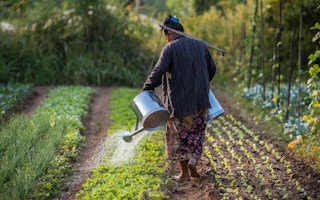What is it with climate change mitigation projects? Why have so many projects developed in Asia, but so few featuring women as agents of change and/or in productive roles? Do project developers and entrepreneurs not feel the need to include women? Or is it that climate change adaptation and mitigation mechanisms fail to explicitly recognize women’s contribution?
Since women often spend the money they earn on services with wider societal benefits such as family nutrition, health and education, what are the costs of direct or indirect exclusion? How can women become more actively engaged in climate planning as well as receive and share the benefits of this engagement? Let’s explore further.
An ADB technical assistance project funded by the Nordic Development Fund that seeks to harness climate change mitigation initiatives to benefit women in Cambodia, the Lao People’s Democratic Republic and Viet Nam is seeking some of those answers. The project is pioneering efforts to incorporate women in climate mitigation planning at multiple levels through collaboration with government ministries and stimulating multi-stakeholder dialogues, to ensure that mitigation-related policies are formulated and implemented in a gender-sensitive manner. Pilot interventions aim to empower women in productive roles and as active agents of change, while also showing governments what gender-sensitive climate change programs look like.
“
When women can access the opportunity they can make a difference and stimulate national economic growth. Women have important knowledge and skills in natural resource and energy management that supports households and communities to mitigate and adapt to climate change, and need to use these skills creatively as it is women who are disproportionately affected by climate change.
Here are some of the lessons learned from the pilots that focus on women as sales agents, producers or entrepreneurs in improved and advanced cookstoves and the biogas sector, as well as a few bottlenecks we are targeting for removal.
- Lack of essential skills often excludes women from key positions. In the biogas value chain in Viet Nam, many work as assistants, carrying water and materials, and supporting masons, but they lack the masonry experience necessary to be eligible for the National Biogas Program’s training for biogas construction team leaders, so less than 1% of over 1,600 trained micro-enterprises are female-led. The project addresses this issue with basic masonry skills training prior to the standard 2-day training sessions.
- A similar barrier is preventing women from getting the most out of cookstoves. It is well documented that women benefit from the better air quality provided by cleaner stoves, but less well known is the fact that women in the Mekong region often play a role in manufacturing the stoves but rarely own the stove production centers. The project is therefore supporting female-led production centers, startups, and potential access to investment loans. In Cambodia, specifically, transport and safety are major concerns for women sales agents in the cookstove value chain. By introducing the sales agents to local governments, and facilitating good relationships in the district, the project is helping overcome these difficulties.
- There is a downside to inclusion. Including women equally in the value chains may involve costs for additional training, tools, or meetings. While most people see this as a burden, few actually make a financial calculation to learn what additional income or impact, equal inclusion of women generates.
- Bias against women in leading or technical roles is common. In Viet Nam, for instance, I often hear that biogas construction or manufacturing clean cookstoves is too hard for women. This is frequently expressed without consulting the target group, or realizing that women already do a lot of the physical work in the sector. Furthermore, the cultural tradition that men work with men results in local governments or entrepreneurs selecting only male partners or trainees. Through community awareness workshops, adjusted selection procedures and gender sensitization of key partners, the project is addressing this discrimination.
And then there is us. We women undersell ourselves. When those of us working on the project first approached women, they responded with “we are afraid to disappoint you” or “perhaps we cannot do this.” These responses are often a reflection of gender inequality and its accompanying insecurities. To a significant extent, these insecurities stem from and reinforce the lower skill levels, the costs of inclusion, and biases discussed above. Believing in the benefits of women’s active engagement in the climate change mitigation sector, we pushed on, combining training with self-esteem exercises and awareness raising on women’s rights. However it totally feeds into the points above, that when there is bias, higher costs and lower skill levels, we almost understand those that bypass the opportunity for women’s inclusion.
But we don’t! No, we don’t understand. Inclusion of women must be embedded in every initiative. When women can access the opportunity they can make a difference and stimulate national economic growth. Women have important knowledge and skills in natural resource and energy management that supports households and communities to mitigate and adapt to climate change, and need to use these skills creatively as it is women who are disproportionately affected by climate change. Due to dependence on these same natural resources, their livelihoods are more severely affected in case of disasters, and their role in climate change mitigation activities is key to being successful. Excluding women also undermines economic growth, as half of the population is not active in productive roles.
From the technical assistance we can already see that inclusion is leading to empowerment of women at both household and community levels. Higher quality products are being produced and marketed, while several strong entrepreneurs and leaders have been identified. However, additional efforts will be needed to draw lessons from the technical assistance. We will update you on other elements of the enabling environment (policy dialogue) that will help spread and deepen the impacts of climate mitigation on women and men in Southeast Asia and elsewhere.
Dagmar Zwebe is Sector Leader for Renewable Energy, SNV. This post is republished from the ADB blog.











